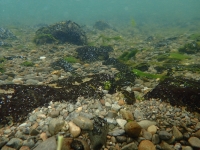I want to...
Current filter: Most popular
A to Z
Apply for a job
Biosecurity
Consents
Consultation
Contact Us
Environmental Data
Farmers Hub
Fix it or Report it
Information Request
Join an Event
Leasehold Land
Meetings
Rates
Water Metering
Have Your Say
Take Care With Dogs On Rivers
Published: 2 November 2016

With summer coming, plus the combination of lower river levels and warmer water temperatures, Hawkes Bay Regional Council is recommending that dogs should be kept under control at the region’s braided rivers because of the risk of the potentially toxic algae, Phormidium, being present.
Phormidium is an algae that occurs naturally in shallow rivers. It occurs in back country rivers as well as low land rivers and is not just a low land river issue. Phormidium algae looks like a blackish mat that forms on rocks.
Hawke’s Bay Regional Council staff do a visual check for the presence of algal mats, when doing weekly water quality sampling, but this by no means takes in the whole river. HBRC staff are considering using a drone flyover more regularly to check for algae in longer reaches of the rivers where it often occurs.
However river users can check for themselves by looking for the black mats where Phormidium tends to grow - in fast-flowing parts of the river known as riffles.
“Research still cannot tell us what triggers Phormidium to start to produce toxins. It’s made more complicated because toxins may be present in one part of the mat, but not in others. The best advice we can give is to treat as potentially toxic all Phormidium growth in the water and drying mats on the banks,” says Anna Madarasz-Smith, HBRC’s water quality scientist.
Dogs appear to be attracted to the drying mats, and are known to get sick from either investigating the mats or drinking water with algae in it. A dog died last summer after being at the river although it was not definitively linked to algae.
“Unfortunately, vets tell us that it’s not a clear cut diagnosis to make the link with algae ingestion, as the symptoms of Phormidium poisoning in dogs closely resemble heat exhaustion,” she said. Dogs can get very hot as they are closer down to the heat coming off the gravel alongside a river.
The best advice for taking dogs walking at the river during summer –
- Keep dogs under control at all times. Don’t let dogs drink from the river during summer, and don’t let them investigate the weed mats.
- Take a bottle of water and bowl for the dog to drink from, especially if you are by the river for some time.
- Give your dog a good drink before you leave home.
Dog owners should take their pets to a vet quickly when they show any unusual symptoms or behaviours.
The water quality monitoring programme is managed jointly by Hawke’s Bay Regional Council with the Public Health Unit of Hawke’s Bay District Health Board. Local councils also take a role in ensuring the public are well-informed about water quality.
Disclaimers and Copyright
While every endeavour has been taken by the Hawke's Bay Regional Council to ensure that the information on this website is
accurate and up to date, Hawke's Bay Regional Council shall not be liable for any loss suffered through the use, directly or indirectly, of information on this website. Information contained has been assembled in good faith.
Some of the information available in this site is from the New Zealand Public domain and supplied by relevant
government agencies. Hawke's Bay Regional Council cannot accept any liability for its accuracy or content.
Portions of the information and material on this site, including data, pages, documents, online
graphics and images are protected by copyright, unless specifically notified to the contrary. Externally sourced
information or material is copyright to the respective provider.
© Hawke's Bay Regional Council - www.hbrc.govt.nz / +64 6 835 9200 / info@hbrc.govt.nz


